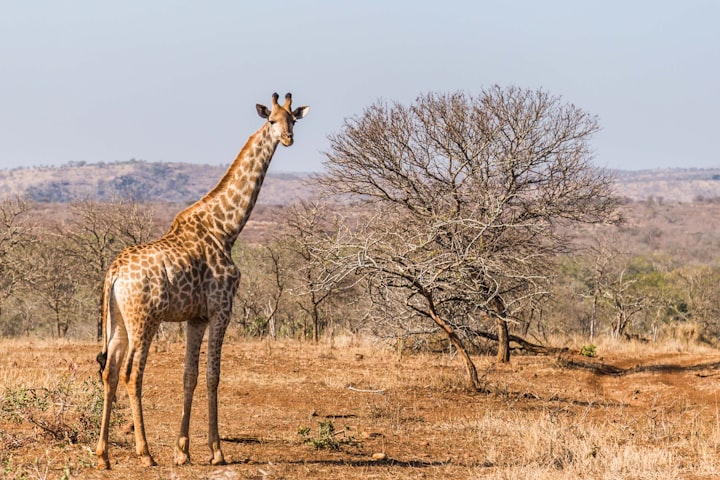Nature's love affair? Giraffe and Acacia, you and I have been fighting for millions of years with a lot of strange tricks
How did the giraffe come to be

The African savannah is always home to a variety of species full of natural characteristics.
From hippos to lions to natural decomposers like vultures, the African continent is one of the places where species originated on Earth and where human civilization is dependent.
The herbivores of the continent are perhaps of more interest than the fierce carnivores.
Not only because of their scarcity but also because of the most important aspect.
This group of animals compared to other continents has biological evolutionary pressure combined with competition between species making them play their own strongest evolutionary survival ability.

The giraffe is a good example of a long neck and long, thin legs.
But it only looks long and slender giraffe legs are quite thick and strong.
After all, in a 4, 5-meter-tall giant animal compared to other parts of itself, the legs naturally seem weak.
But to think so can be wrong, even the lion in hunting giraffe when you have to think carefully about the response strategy.
Because a careless giraffe may be strong front legs to kick dead, and the giraffe in the zoo is different, the wild giraffe is no less dangerous than large carnivores.
In Darwin's theory of biological evolution, the giraffe will appear as such a change is entirely due to competitive pressure brought about.
This changed the appearance of giraffes, including competition for survival among them and sexual selection.
Early giraffes did not have long necks like today's giraffes, instead, they looked similar to today's mergansers.
As a family of giraffes in the even-toed order, today only two extant genera remain after millions of years of evolution of this species.

Comparisons between giraffes and their distant relatives show that the vertebrae near the skull began to evolve at a very early stage.
The vertebrae then lengthened further downward and gradually shifted towards the development of the modern giraffe.
Their ancestors lived between 25 and 20 million years ago, a period when giraffes were about the size of antelopes and were lithe.
Aftr millions of years of evolution, giraffes began to appear in the Indian subcontinent, at which time their form probably resembled that of a small giraffe.
Scientists believe that the climate shift was an important reason for the extinction of the ancient giraffe, and also for the giraffe's journey to the African continent.
After coming to the African continent, the changes brought by the environment became the main driver of giraffe evolution to survive.
The secret in the neck
During this period, tropical plants disappeared and were replaced by plants that could adapt to carbon 4.
Some researchers hypothesize that this new habitat is coupled with a different diet, such as the consumption of Acacia species.
The resulting exposure of the giraffe's ancestors to toxins may have led to higher mutation rates and higher rates of evolution.
Also, by comparing ancient giraffes, scientists have shown that the modern giraffe's fur mass may also coincide with changes in habitat.
Brown fur with patchy patterns can help giraffes better conceal themselves in the open savannah, thus reducing the impact of predators.
Of course, the biggest change in the giraffe is its neck.
Modern giraffes can reach a neck length of 2 meters, and this is not the maximum height, the highest record even reached 2.4 meters.
Regarding the hypothesis of the evolution of giraffe neck length, Darwin initially proposed the hypothesis of feeding competition.
Feeding pressure from other ruminants and herbivores, giraffes needed access to food unavailable to competitors to enhance their survival advantage.
And this advantage did exist because giraffes could consume acacia plants up to 4.5 meters tall.
And this is the giraffe and acacia plant between millions of years of struggle.
Giraffes can eat 29 kilograms of acacia plants a day, and usually, not only one or two giraffes eat this plant.
For giraffes, it is necessary to consume plants full of nutrients to keep the day running.
Especially in the evolution of the giraffe, the Acacia plant has plenty of calcium and protein to help the giraffe grow.
But the acacia is not a plant that goes against the grain and has to pay a price if it wants to eat itself.
At first, the acacia plant just thought of ways to make itself grow taller.
However, the giraffe, due to environmental pressure, thus followed the development of its long neck.
As a plant that can grow in arid zones, Acacia can endure long periods of extreme drought.
However, they do not live long, generally surviving only 20 to 30 years.
They can also provide sufficient water for giraffes during droughts, so if they are eaten clean, won't it be too humiliating?
So Acacia evolved spikes, these thick spikes up to 10 cm, can effectively resist other animals gnawing, but also reduce their water loss.
But giraffes do not care about acacia this kind of look is covered with spikes, and giraffes have evolved 45 cm long tongues.
The soft and slender tongue can easily eat the young leaves of acacia covered with spikes.
The evolutionary war between the two was fought, with Acacia desperately trying to grow taller and more dangerous, and giraffes following suit.
A fierce species competition
During the millions of years of struggle, the two continued to get stronger.
Acacia later evolved to synthesize a phlorotannin.
Tannin is a water-soluble carbon-based compound in plants that is still quite important to humans.
Their chemical and physical properties allow alkaloids, gelatin, and other proteins to bind well during processing.
And in food science, the right tannins can add to the taste of wine and cocoa.
But that's not good for giraffes.
Tannins interfere with proteins and digestive enzymes, as well as bind to consumed plant proteins, making them harder to digest and providing some inhibitory effects.
In short, this stuff is easy to eat too much indigestion.
In addition, the evolution of tannins in Acacia has led to the convergent evolution of nearby plants.
The plants near the acacia also began to evolve tannins, which makes the giraffe must look for acacia elsewhere to fill their food gap.
Tannin is perhaps the greatest killer of acacia plants.
Since there is no way to solve the giraffe nothing is always eating itself, simply making itself more difficult to eat, is to die to make the giraffe hard to suffer.
Not only that, but the Acacia plant is also in the process of evolution, and ants form a mutually beneficial relationship.
The ants are called "spiny ants" and the acacia plant allows them to build nests in their thorny locations, which the ants empty to produce a sweet nectar.
The nectar attracts other insects that help the acacia plant disperse its offspring, and in return for shelter and food, the spiny ants will attack any animal that wants to eat the acacia.
It is known that about 20,000 spiny ants are living on a single acacia tree as a way to protect the acacia from damage.
Now with further research by biologists and paleontologists, new insights have emerged from Darwin's early days about the evolution of the giraffe and the changes in its external features.
In addition to the selection brought about by feeding pressure, scientists also believe that giraffes' necks can help them accomplish competition among their herds.
A long, strong, robust neck helps giraffes outwit their opponents in a fight, and for giraffes, a neck fight is necessary to gain mating rights.
Whoever has the stronger neck gets the right to mate, and the loser usually suffers a broken neck and dies shortly thereafter.
In addition, in the food selection hypothesis, the academic community also began to appear in some opposing voices.
Because of food selection pressure, African goats did not evolve long necks to eat young leaves, instead, they will climb the tops of trees to eat leaves.
And giraffes have evolved longer and stronger forefeet, which also seems to indicate that the relationship between leg length and neck is not necessary to facilitate the consumption of plants.
Neck length depends on people's views and observations of giraffe behavior or environmental anatomy.
Only a multifaceted analysis can further explain the giraffe neck issue.
For the moment, however, there is a preference for Darwin and the early giraffe research claims.
Giraffes and acacias, the pair of enemies, love each other, and perhaps in the future, people will see new convergent evolution and more exotic acacia plants.
About the Creator
Richard Shurwood
If you wish to succeed, you should use persistence as your good friend, experience as your reference, prudence as your brother and hope as your sentry.






Comments
There are no comments for this story
Be the first to respond and start the conversation.